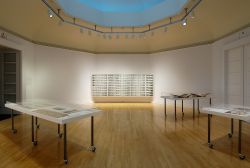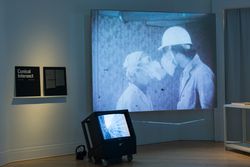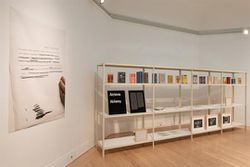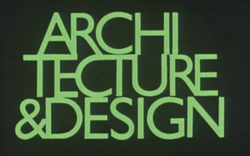archives
Level of archival description:
Fonds
AP194
Synopsis:
The Johan Bettum OCEAN North projects records, 1995-2000, consist of born-digital files and a physical drawing that document three projects by the OCEAN North collective: Synthetic Landscape (1995-2000), Jyväskylä Music and Arts Centre (competition, 1997), and Tölöö Football Stadium (competition, 1997). The archive also includes a small amount of additional born-digital reference materials on 11 projects from the collective, including the three projects mentioned above.
1995-2000
Johan Bettum OCEAN North project records
Actions:
AP194
Synopsis:
The Johan Bettum OCEAN North projects records, 1995-2000, consist of born-digital files and a physical drawing that document three projects by the OCEAN North collective: Synthetic Landscape (1995-2000), Jyväskylä Music and Arts Centre (competition, 1997), and Tölöö Football Stadium (competition, 1997). The archive also includes a small amount of additional born-digital reference materials on 11 projects from the collective, including the three projects mentioned above.
archives
Level of archival description:
Fonds
1995-2000
During the Second World War, exhibitions and publications played a critical role in the war effort. They were organized internationally as moments of reflection and propaganda, productions of a disciplinary approach to architecture and urban design. This display springs from Jean-Louis Cohen’s research for Architecture in Uniform: Designing and Building for the Second(...)
Hall cases
13 April 2011 to 18 September 2011
A Paper War: Pictures and words, 1939-1945
Actions:
Description:
During the Second World War, exhibitions and publications played a critical role in the war effort. They were organized internationally as moments of reflection and propaganda, productions of a disciplinary approach to architecture and urban design. This display springs from Jean-Louis Cohen’s research for Architecture in Uniform: Designing and Building for the Second(...)
Hall cases
German artist Dieter Appelt presents a major work commissioned by the CCA and inspired by the late nineteenth-century Forth Rail Bridge near Edinburgh, Scotland. Dieter Appelt: Forth Bridge — Cinema. Metric Space is the second of four exhibitions in the Tangent series, which brings contemporary artists into dialogue with the CCA Collection and results in newly(...)
Octagonal gallery
9 March 2005 to 22 May 2005
Dieter Appelt: Forth Bridge - Cinema. Metric Space
Actions:
Description:
German artist Dieter Appelt presents a major work commissioned by the CCA and inspired by the late nineteenth-century Forth Rail Bridge near Edinburgh, Scotland. Dieter Appelt: Forth Bridge — Cinema. Metric Space is the second of four exhibitions in the Tangent series, which brings contemporary artists into dialogue with the CCA Collection and results in newly(...)
Octagonal gallery
Tangent - Alain Paiement
The first in a series of exhibitions that invites artists to create new work in response to a corpus of photographs selected from the CCA’s collection. In a provocative installation, Québec artist Alain Paiement juxtaposes a wide range of photographic subjects from the collection – buildings under construction, models of student work, architectural abstractions, different(...)
23 April 2003 to 23 November 2003
Tangent - Alain Paiement
Actions:
Description:
The first in a series of exhibitions that invites artists to create new work in response to a corpus of photographs selected from the CCA’s collection. In a provocative installation, Québec artist Alain Paiement juxtaposes a wide range of photographic subjects from the collection – buildings under construction, models of student work, architectural abstractions, different(...)
The architectural practice OFFICE was founded in Belgium in 2002 by Kersten Geers and David Van Severen. They have contributed to past CCA exhibitions including Imperfect Health: The Medicalization of Architecture (2011). The series They want to speak with you invites design and architecture professionals to discuss their most recent projects.
13 November 2014 , 6pm
OFFICE wants to speak with you
Actions:
Description:
The architectural practice OFFICE was founded in Belgium in 2002 by Kersten Geers and David Van Severen. They have contributed to past CCA exhibitions including Imperfect Health: The Medicalization of Architecture (2011). The series They want to speak with you invites design and architecture professionals to discuss their most recent projects.
Anna Neimark and Andrew Atwood of First Office present recent work on exhibitions and display, including a temporary screening room installed at the MAK Center for Art and Architecture in Los Angeles. Presented as part of Displaying Architecture, a CCA series that looks at the relationship between architecture and spaces of display.
22 October 2015 , 6pm
Displaying Architecture: First Office
Actions:
Description:
Anna Neimark and Andrew Atwood of First Office present recent work on exhibitions and display, including a temporary screening room installed at the MAK Center for Art and Architecture in Los Angeles. Presented as part of Displaying Architecture, a CCA series that looks at the relationship between architecture and spaces of display.
Octagonal gallery
27 September 2019 to 19 January 2020
Octagonal gallery
Octagonal gallery
7 February 2020 to 4 October 2020
Octagonal gallery
Octagonal gallery
7 June 2019 to 8 September 2019
Octagonal gallery
articles
A history of references








